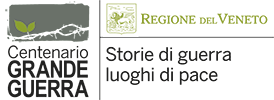- Luoghi da non perdere
-
 opere militari
opere militari -
 campi di battaglia
campi di battaglia -
 luoghi di comando e di retrovia
luoghi di comando e di retrovia -
 cimiteri, sacrari e monumenti
cimiteri, sacrari e monumenti -
 musei e raccolte
musei e raccolte -
 altri siti di interesse
altri siti di interesse
- Tutti i luoghi
-
 opere militari
opere militari -
 campi di battaglia
campi di battaglia -
 luoghi di comando e di retrovia
luoghi di comando e di retrovia -
 cimiteri, sacrari e monumenti
cimiteri, sacrari e monumenti -
 musei e raccolte
musei e raccolte -
 altri siti di interesse
altri siti di interesse
The Sacred River
There are few places with as much evocative power as the Piave river banks. Crossing one of its bridges, you cannot avoid seeing signs of the collective memory: the sign with that prophetic phrase "River sacred to the Homeland", the flag always waving nearby, the names of places and villages that often end with the specification "of the Battle". The three formidable battles fought on the two shores (the Battaglia d'Arresto, November 1917; the Battaglia del Solstizio, June 1918; the battle of Vittorio Veneto, October 1918) had as an involuntary protagonist the river itself; then much more energetic and rich in capacity. Austro-Hungary exhausted its last resources and the Royal Italian Army and its allies got their luck back on the river. The route follows both Piave banks alternatively; in a context strongly affected by human impact with its monuments and the remains of military emplacements. Descending along the Left Piave, at Tezze di Vazzola you have the British Cemetery containing the bodies of 356 soldiers who died during the last battles on the Grave di Papadopoli. This rises in the well preserved farm village of "Malanotte" which held one of the main Imperial artillery shooting stations, protected by an underground bunker, still preserved. In Maserada, on the other bank, a monument is dedicated to the 7th British division along with a museum with interesting exhibits mainly found on the river bed. Descending along the shore you cross Molino della Sega, theatres of battles mainly involving the fresh, young soldiers, since then called "Ragazzi del '99" (boys of 99) and reach Fagarè, with another imposing War Memorial and the remains of more than ten thousand III Army soldiers. To the sides of the memorial, two wall fragments with some historical phrases written by soldiers during the Battle of the Solstice. The Piave cove in Zenson is the next stage on this itinerary; the river slows down near its outlet and creates a number of coves. The Zenson is remembered as one of the bloodiest of the 1917/18 battles that took place along the river. It is worth ending with Monastier, at the Abbazia del Pero. Next to the belltower, used by the Italians as an observation post, you can still see the foundations of the destroyed church. And nearby a rustic villa which gave hospitality to a wounded Hemingway while he was serving in the Red Cross (see the itinerary "Hemingway's War"). To the north, the itinerary can link to the one called "The Battle of the Solstice", and to the south can continue with those called "The empire's last attack " and "The Piave island".
Source: Provincia di Treviso e ecomuseograndeguerra.it


 Dolomiti e area di Belluno
Dolomiti e area di Belluno  Altopiano di Asiago, Pasubio e area di Vicenza
Altopiano di Asiago, Pasubio e area di Vicenza  Grappa, Tomba, Montello, area di Treviso e Piave
Grappa, Tomba, Montello, area di Treviso e Piave  Venezia e Laguna
Venezia e Laguna  Baldo, Lessinia e area di Verona
Baldo, Lessinia e area di Verona  Area di Padova
Area di Padova  Area di Rovigo
Area di Rovigo  cerimonie
cerimonie  rievocazioni
rievocazioni  spettacoli
spettacoli  mostre
mostre  incontri
incontri  didattica
didattica  manifestazioni
manifestazioni  altro
altro  1915
1915 
 resta informato
resta informato download
download

